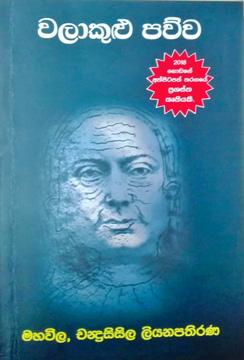
Book: ‘Valakulu Pavva’
Author:Mahawila, Chandrasisila Liyanapathirane
Godage Publishers, Colombo 10
Price: Rs 600
The novel is a literary form so wide in its range that generalizations about it are almost impossible. The play has certain conventions imposed on it by the stage and the audience. A poem is intended to express one main emotion. The short story has certain limitations. However, the novel has no such limitations or rules and there is no such thing as the art of fiction. Therefore, we cannot compare one novel with another. Despite such a wide freedom available to the novelist, books have been written on the art of fiction. According to them, a novel should have a narrative, plot and a definite point of view. Mahawila, Chandrasisila Liyanapathirane’s ‘Valakulu Pavva’ obviously has a narrative, a plot and a point of view. Percy Lubbock in ‘The art of fiction’ says, “The point of view is the relation in which the narrator stands to the story. In the novel under review, the narrator is an aged woman who has weathered many a storm in life. She tells her story in the first person but assumes omniscience at times.
The narrator belongs to a group of people who have retired from their active life. She relates the important incidents in her life and family quite openly. Being the eldest daughter in a lower middle class family, she has to look after three younger sisters. She was employed as a teacher and others depended on her income.
The reader is exposed to her life right from the beginning. She talks about her childhood, youth and her role as a teacher and a wife.
The author has brought to life many incidents in her life mostly through flashbacks. Before marriage she constantly clashed with her sisters. Even her marriage that takes place late in her life does not bring her contentment. The reader does not hear her story chronologically. She dips into her childhood and then marriage.
In between she narrates many other incidents which may not be directly connected to what she is telling. Psychologically this is quite true. Most elderly people are unable to think or talk coherently. As a result the novel is full of flashbacks.
The narrator strikes a note of happiness despite the ups and downs in her life. Her employment as a teacher gave her a sense of pride and security. But her marriage to someone who does not take life seriously does not bring her any happiness. When her husband dies her plight becomes pathetic.
While the narrator is at her task, the author gives us a graphic account of the village life and its splendour. He creates word pictures of waterways, fields, hills and the rain beautifully which reminds me of J. Vijayatunga’s Grass for My Feet.
The novel holds a mirror to the changing life of a village. The original beauty of village life is vitiated by the advent of party politics and economic struggles people had to face. Those who dedicated their lives for the welfare of the poor villagers are no longer to be seen. The narrative moves somewhat slowly but steadily. When you read the novel from cover to cover, you feel a sense of enlightenment.
You will pause for a moment and wonder why human life is so complex and tragic.
